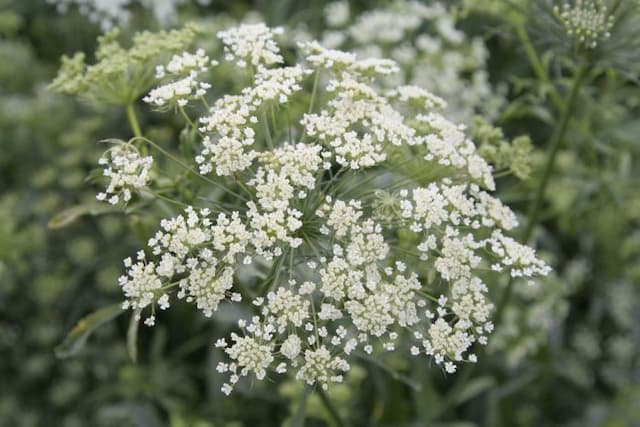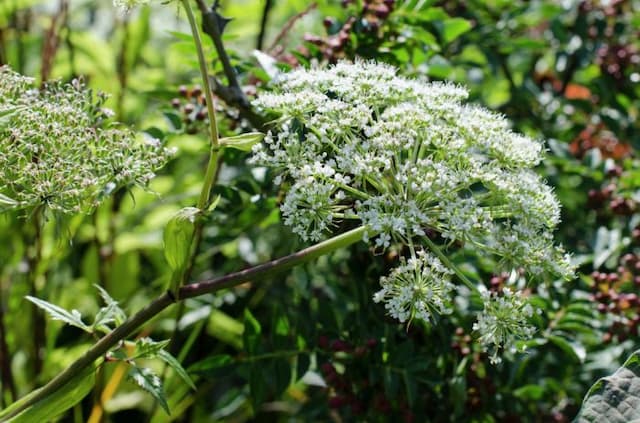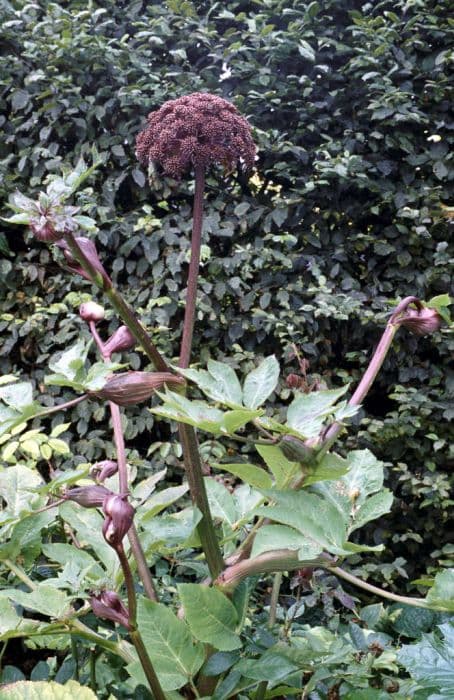Wallich Milk Parsley Selinum wallichianum

ABOUT
Selinum wallichianum, commonly known as Wallich milk parsley, is a perennial herb that boasts a complex aesthetic. This plant typically displays a lush, green foliage with leaves divided into numerous fine leaflets that lend a delicate, feathery appearance. The leaves are arranged in a basal rosette near the ground, with a few also growing alternately up the stem. The Wallich milk parsley is noted for its striking umbrella-like clusters of flowers, known as umbels. These large, flat-topped clusters typically bear numerous tiny flowers which are usually a subtle shade of white or pale cream. The delicate flowers are small and numerous, contributing to the plant's overall lacy effect. The stems of Wallich milk parsley are erect, branching, and ridged, rising above the foliage and bearing the clusters of flowers. These stems add an architectural element to the plant's form, creating a contrasting frame for the softness of the leaves and flowers. The root system of Wallich milk parsley is robust, with a substantial taproot that anchors the plant firmly into the ground. Additionally, the seeds of the Wallich milk parsley are small and may have slight ribs or wings, which help in their dispersal by wind or animals. Overall, the Wallich milk parsley presents a graceful silhouette, with an intricate play of textures from the fine foliage to the clustered blooms, making it an attractive addition to naturalistic plantings or as a focal point in a garden setting.
About this plant
 Names
NamesFamily
Apiaceae.
Synonyms
Wallich Milk-parsley, Himalayan Celery, Bhutkesh, Bhutkeshi.
Common names
Peucedanum wallichianum, Selinum tenuifolium, Athamanta wallichiana.
 Toxicity
ToxicityTo humans
Selinum wallichianum, commonly known as the Wallich milk-parsley, is not widely reported as a toxic plant to humans. Therefore, there is limited information on its toxicity and the symptoms that may arise from ingesting any parts of this plant. However, as with many plants, individual sensitivity can vary, and it is still advisable to avoid consuming parts of plants that are not commonly recognized as food, as they may contain compounds that could be potentially harmful. If you suspect ingestion and observe any symptoms, it is important to seek medical attention.
To pets
There is limited information available regarding the toxicity of Selinum wallichianum, or Wallich milk-parsley, to pets. It is not well-documented as a poisonous plant for pets like cats and dogs; however, caution should be exercised as different animals may have varying levels of sensitivity to plant compounds. Ingesting unknown plants can sometimes lead to gastrointestinal upset or more severe symptoms in pets. If you suspect that your pet has consumed any part of this plant and is showing signs of illness, consult with a veterinarian as soon as possible.
 Characteristics
CharacteristicsLife cycle
Perennials
Foliage type
Deciduous
Color of leaves
Green
Flower color
White
Height
4 feet 9 inches (1.45 meters)
Spread
2 feet (0.61 meters)
Plant type
Herb
Hardiness zones
5
Native area
Himalayas
Benefits
 General Benefits
General Benefits- Supports Biodiversity - The flowers of Chuanxiong provide nectar and pollen for various insects, facilitating pollinator visits and ecosystem health.
- Landscape Aesthetics - Chuanxiong adds visual interest to gardens and landscapes with its lush foliage and attractive flower clusters.
- Soil Erosion Control - The root systems of Chuanxiong can help stabilize soil and prevent erosion on slopes or in areas of disturbance.
- Cultural Significance - In certain regions, it holds cultural importance and may be used in religious ceremonies or traditional local practices.
- Culinary Use - In some cultures, parts of the plant may be used as a flavoring agent or spice in cooking, contributing to culinary diversity.
- Ecological Balance - As a native species in its habitat, Chuanxiong plays a role in maintaining the ecological dynamics and balance within its native ecosystem.
 Medical Properties
Medical Properties- Anti-inflammatory: Selinum wallichianum has been traditionally used to reduce inflammation.
- Analgesic: The plant may possess pain-relieving properties.
- Carminative: It is sometimes used to relieve flatulence.
- Antipyretic: It may help in reducing fever.
- Diuretic: The plant has been used to promote urination and relieve fluid retention.
- Antioxidant: Contains compounds that might combat oxidative stress.
- Hepatoprotective: It may offer some protection to the liver.
- Nervine: Traditionally used to calm the nerves and treat neurological disorders.
- Antirheumatic: Employed in traditional medicine for treating rheumatism.
 Air-purifying Qualities
Air-purifying QualitiesThis plant is not specifically known for air purifying qualities.
 Other Uses
Other Uses- Dye Production: The roots of the Himalayan Selinum can be utilized to create a natural dye, suitable for textile industry.
- Traditional Ceremonies: In some cultures, parts of the Himalayan Selinum may be used in ceremonial offerings or as decorations during festivals.
- Insect Repellent: The strong aroma of the Himalayan Selinum can act as a natural repellent against certain insects when planted in a garden or when applied in its essential oil form.
- Aromatherapy: Essential oils derived from Himalayan Selinum might be used in aromatherapy practices for their unique scent and relaxing properties.
- Gardening Companion Planting: Himalayan Selinum might be grown alongside other plants in a garden to enhance soil nutrients and repel pests through its scent.
- Floral Arrangements: The flowers and foliage of Himalayan Selinum can be used in cut-flower arrangements for their aesthetic appeal.
- Photography Prop: The Himalayan Selinum, with its intricate flowers and foliage, can serve as a photogenic subject or backdrop in nature photography.
- Culinary Garnish: Although non-edible, the delicate flowers might be used as a temporary garnish for plating in high-end culinary presentations.
- Soil Erosion Control: The plant's root system may be effective in holding soil, preventing erosion on slopes or in areas with loose earth.
- Animal Bedding Material: Dried foliage of Himalayan Selinum may be used as a bedding material in livestock shelters due to its possibly pest-repellent properties.
Interesting Facts
 Feng Shui
Feng ShuiThe Himalayan Cranesbill is not used in Feng Shui practice.
 Zodiac Sign Compitability
Zodiac Sign CompitabilityThe Himalayan Cranesbill is not used in astrology practice.
 Plant Symbolism
Plant Symbolism- Healing: Selinum wallichianum, commonly known as the Himalayan Lovage, has been used in traditional medicine, symbolizing healing properties, especially in Ayurveda.
- Mysticism: Due to its use by Himalayan shamans and its presence in spiritual rituals, Himalayan Lovage is often associated with mysticism and the unseen aspects of nature.
- Protection: The plant is believed to offer protection against spirits and negative energies, reflecting the belief that nature can shield and provide safe haven.
- Purity: Growing in high altitudes and less-polluted environments, Himalayan Lovage is symbolic of purity and the untouched aspects of nature.
- Endurance: Its ability to thrive in harsh mountainous climates makes it a symbol of endurance and adapting to challenging conditions.
 Water
WaterThe Himalayan Honeysuckle should be watered regularly, aiming to keep the soil consistently moist but not waterlogged. During the growing season, water the plant approximately once a week, providing around one to two gallons depending on the size of the plant and the weather conditions. In hot, dry periods, the frequency may need to increase. In the dormant season, reduce watering but do not let the soil dry out completely. Monitor the soil moisture level to adjust watering as needed, ensuring good drainage to prevent root rot.
 Light
LightHimalayan Honeysuckle thrives in full sun to partial shade. The ideal location would provide morning sunlight with some afternoon shade, or dappled sunlight throughout the day. Avoid deep shade as it can lead to poor growth and fewer flowers. An east- or west-facing spot is optimal to fulfill the light requirements of this plant.
 Temperature
TemperatureHimalayan Honeysuckle is hardy and can tolerate a range of temperatures, withstanding a minimum temperature of about -5°F and thriving in temperatures up to 85°F. The ideal temperature range for this plant lies between 50°F and 70°F for optimal growth. It is important to protect the plant from extreme cold by providing mulch or cover during the coldest months.
 Pruning
PruningPruning Himalayan Honeysuckle is necessary to maintain its shape, encourage vigorous growth, and enhance flowering. It is best pruned in late winter or early spring before new growth begins. Remove any dead or damaged stems, and thin out overcrowded areas to improve air circulation. Deadheading spent flowers will promote a longer blooming period and potentially a second bloom in the same season.
 Cleaning
CleaningAs needed
 Soil
SoilWallich milk parsley thrives best in a soil mix that is well-draining, rich in organic matter, and has a slightly acidic to neutral pH ranging from 6.0 to 7.0. A combination of loamy garden soil, compost or well-rotted manure, and some sand or perlite to improve drainage creates an ideal environment for its growth.
 Repotting
RepottingWallich milk parsley typically doesn't require frequent repotting and can be repotted every 2-3 years, or when it outgrows its current pot. It is important to use a pot with adequate drainage holes to avoid waterlogging.
 Humidity & Misting
Humidity & MistingWallich milk parsley prefers moderate humidity levels and can thrive in outdoor environments with the ambient moisture. However, if grown indoors, maintaining humidity levels around 40-50% would be beneficial for the plant.
 Suitable locations
Suitable locationsIndoor
Provide bright, indirect light and moderate humidity for indoor Wallich milk parsley.
Outdoor
Place in partial shade with moist soil for outdoor Wallich milk parsley.
Hardiness zone
5-7 USDA
 Life cycle
Life cycleSelinum wallichianum, commonly known as Wallich milkparsley, begins its life cycle as a seed that germinates in moist soil. After sprouting, the seedling develops into a rosette of pinnate, feathery leaves at ground level. As the plant matures, it forms an upright stem that extends upwards, bearing compound umbels of small white or pale pink flowers which attract various pollinators. Following pollination, flowers develop into schizocarp fruits that split into two seeds, ensuring the dispersal and continuation of the species. The plant is a perennial, and after flowering, it may die back to the rootstock to overwinter before regrowing in the next season. Wallich milkparsley's lifecycle is complete when it reaches maturity, reproduces through seeds, and eventually dies after several growing seasons.
 Propogation
PropogationPropogation time
Late summer
Propogation: The most popular method of propagation for Selinum wallichianum, commonly known as Wallich milkparsley, is through seed sowing. Optimal propagation time is generally in the spring. Seeds should be sown in a well-drained seed starting mix, lightly covered with soil, and kept moist until germination, which typically occurs within 2 to 3 weeks. After the seedlings have developed several true leaves, they can be transplanted into individual pots or directly into the garden, ensuring they are spaced adequately to accommodate their mature size. Care should be taken to protect the young plants from extreme weather conditions and to maintain consistent soil moisture without overwatering to promote healthy growth.









